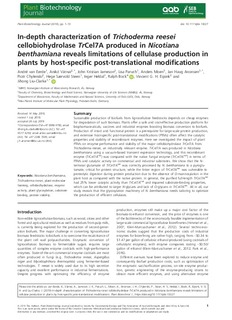| dc.contributor.author | van Eerde, André | |
| dc.contributor.author | Varnai, Aniko | |
| dc.contributor.author | Jameson, John-Kristian | |
| dc.contributor.author | Paruch, Lisa | |
| dc.contributor.author | Moen, Anders | |
| dc.contributor.author | Anonsen, Jan Haug | |
| dc.contributor.author | Chylenski, Piotr | |
| dc.contributor.author | Steen, Hege | |
| dc.contributor.author | Heldal, Inger | |
| dc.contributor.author | Bock, Ralph | |
| dc.contributor.author | Eijsink, Vincent | |
| dc.contributor.author | Clarke, Jihong Liu | |
| dc.date.accessioned | 2019-10-08T12:04:26Z | |
| dc.date.available | 2019-10-08T12:04:26Z | |
| dc.date.created | 2019-09-24T07:49:36Z | |
| dc.date.issued | 2019 | |
| dc.identifier.citation | Plant Biotechnology Journal, 2019. | nb_NO |
| dc.identifier.issn | 1467-7644 | |
| dc.identifier.uri | http://hdl.handle.net/11250/2620915 | |
| dc.description.abstract | Sustainable production of biofuels from lignocellulose feedstocks depends on cheap enzymes for degradation of such biomass. Plants offer a safe and cost‐effective production platform for biopharmaceuticals, vaccines and industrial enzymes boosting biomass conversion to biofuels. Production of intact and functional protein is a prerequisite for large‐scale protein production, and extensive host‐specific post‐translational modifications (PTMs) often affect the catalytic properties and stability of recombinant enzymes. Here we investigated the impact of plant PTMs on enzyme performance and stability of the major cellobiohydrolase TrCel7A from Trichoderma reesei, an industrially relevant enzyme. TrCel7A was produced in Nicotiana benthamiana using a vacuum‐based transient expression technology, and this recombinant enzyme (TrCel7Arec) was compared with the native fungal enzyme (TrCel7Anat) in terms of PTMs and catalytic activity on commercial and industrial substrates. We show that the N‐terminal glutamate of TrCel7Arec was correctly processed by N. benthamiana to a pyroglutamate, critical for protein structure, while the linker region of TrCel7Arec was vulnerable to proteolytic digestion during protein production due to the absence of O‐mannosylation in the plant host as compared with the native protein. In general, the purified full‐length TrCel7Arec had 25% lower catalytic activity than TrCel7Anat and impaired substrate‐binding properties, which can be attributed to larger N‐glycans and lack of O‐glycans in TrCel7Arec. All in all, our study reveals that the glycosylation machinery of N. benthamiana needs tailoring to optimize the production of efficient cellulases. | nb_NO |
| dc.language.iso | eng | nb_NO |
| dc.rights | Attribution-NonCommercial-NoDerivatives 4.0 Internasjonal | * |
| dc.rights.uri | http://creativecommons.org/licenses/by-nc-nd/4.0/deed.no | * |
| dc.title | In-depth characterization of Trichoderma reesei cellobiohydrolase TrCel7A produced in Nicotiana benthamiana reveals limitations of cellulase production in plants by host-specific post-translational modifications | nb_NO |
| dc.type | Journal article | nb_NO |
| dc.type | Peer reviewed | nb_NO |
| dc.description.version | publishedVersion | nb_NO |
| dc.source.pagenumber | 13 | nb_NO |
| dc.source.journal | Plant Biotechnology Journal | nb_NO |
| dc.identifier.doi | 10.1111/pbi.13227 | |
| dc.identifier.cristin | 1728096 | |
| dc.relation.project | Norges forskningsråd: 257622 | nb_NO |
| dc.relation.project | Norges forskningsråd: 256766 | nb_NO |
| dc.relation.project | Norges forskningsråd: 243974 | nb_NO |
| cristin.unitcode | 192,12,0,0 | |
| cristin.unitname | Kjemi, bioteknologi og matvitenskap | |
| cristin.ispublished | true | |
| cristin.fulltext | original | |
| cristin.qualitycode | 1 | |

